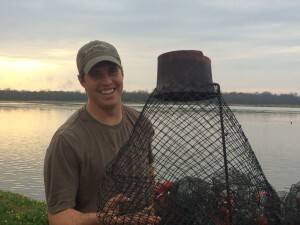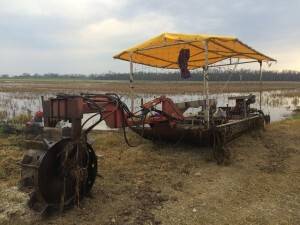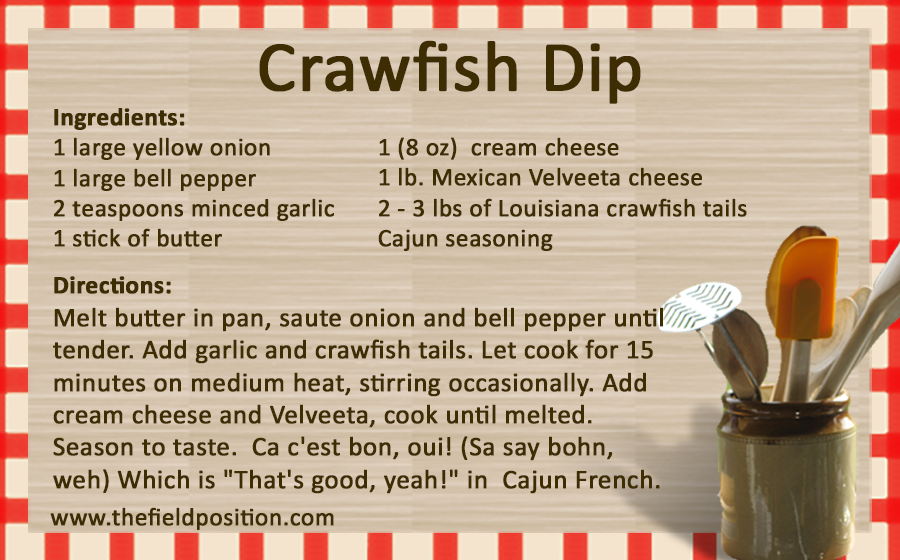It’s Crawfish Season, Y’all… Give “Fresh Catch Friday” New Meaning Tonight!
Just how hot are fresh crawfish in the Bayou State? The demand is so high that it’s hard to find a parking place, and even then, the evening’s Crawfish Boil might be sold out.
Crawfish harvest begins around March 1, says third generation Louisiana farmer Caleb Frey of Morganza, Louisiana. Traps are checked once daily at the beginning of the season and more frequently as the season progresses. Crawfishing runs through the second or third week of May, and then a late crop of rice will be planted in those fields where the crawfish were grown.
Louisiana farmer Caleb Frey of Morganza, Louisiana. Traps are checked once daily at the beginning of the season and more frequently as the season progresses. Crawfishing runs through the second or third week of May, and then a late crop of rice will be planted in those fields where the crawfish were grown.
Sugar cane, soybeans and corn also are grown at Four Oaks Farm. The Frey family raises cattle on the levees that protect their farmland from the Mighty Mississippi. This diversified farming operation lends itself to year-round production.
“What I enjoy most about farming is the change,” says Caleb. “You might have a week or so of the same activity, like planting corn, and then it’s time to move onto the next activity.”
Corn planting was about to get underway around Natchez, Mississippi, when Franklin County Iowa farmer April Hemmes and I arrived. (April and Caleb traveled to China together as part of the United Soybean Board’s See For Yourself program. Applications are being accepted through April 1, so sign up online today to see how checkoff dollars help build markets worldwide for U.S. farm products.)
It had rained just enough the day of our visit that fieldwork came to a halt. So instead of touring the area’s beautiful pre-Civil war antebellum mansions, April and I went on a customized farm tour. Talk about luck! Here’s what we learned during our “short course” in Deep South Farming:
March:
Crawfishing starts around the first of the month. Temperatures need to be in the 70s before the crawfish really start moving, so sometimes the season starts a little later.
Corn planting ideally starts the first or second week of March and will be complete by the month’s end. Last year, the Frey family didn’t start until March 19 and finished on the 30th.
The majority of rice acres are planted from mid-March to early April. Like corn, rice is very sensitive to high temperatures during pollination and needs adequate rainfall. The earlier it gets planted, the better the crop usually is.
April:
Early soybeans, typically early Group 4s, go in the fallow sugarcane ground around April 1.
May:
Most soybean acres are planted in May. Maturities generally range from 4.6 to 5.3.
June:
The Frey family stays busy with irrigating corn, soybeans and sugarcane, as well as spraying.
July:
Irrigating and spraying continues during the month of July as temperatures average 92 degrees Fahrenheit and the monthly rainfall is approximately 6 inches. Early rice and early corn are harvested toward the end of the month.
August:
Corn harvest is in full swing by the first or second week of August. Most of the rice is harvested mid-month, depending on the weather. If there is a hurricane threat, corn harvest is stopped so all hands can get the rice harvested before the weather hits. “Harvesting downed rice is one of the most painstaking things you could ever do in a combine,” explains Caleb. “Add mud to the mix following a big storm and it really gets interesting.”
Early soybeans also are harvested at this time, and the sugarcane planting crews typically follow right behind the combine.
September:
Sugarcane planting and soybean harvest wrap up. Sugarcane needs to grow about one year before it is harvested, so the Freys include this crop as in rotation with soybeans. Harvest begins around the last week of the month on the mature cane crop.
NOTE: The sugar cane gets a little growth on it during the fall, but it typically doesn’t get much more than a foot or two tall before frost causes it to go dormant. In the spring, the entire cane crop basically starts from the same point. It’s cultivated, fertilized, sprayed and irrigated.
Come October the “plant cane,” which is the crop that was planted the previous summer, is harvested along with the rest of the crop. Then it becomes “first year stubble,” which means it has been harvest once. Cane is typically stubbled, or harvested, three to four years before a field returns to soybeans.
October:
Sugarcane harvest cranks up and grain harvest comes to an end in October. Fall field prep is in full swing behind the combines. At this time, a maintenance shot of fertilizer is applied on all of the corn, soybean and rice acres.
November;
Typically all field work is finished by Thanksgiving, weather permitting. Sugarcane harvest is in full swing.
December:
Cane harvest is typically finished between Christmas and the first of the year, but the finish date is completely dependent upon the sugar mill. The mill determines the producers’ daily quota. Your quota is proportional to your cane acres and harvest is typically figured on a 90- to 100-day timeframe.
Additional information: During that 100-day window, each farmer gets one day off every other week. Moisture has no effect on the milling or harvest process, so harvest continues.
During harvest or “grinding” as it’s called here, cane is being harvested 24/7 from September through January. All farmers who haul a particular mill generally finish harvest on the same day, but finish dates vary across the state by a few weeks.
There are 11 sugar mills in Louisiana, and each mills sets its own schedule to a certain degree. Some have split shifts, which means half of their farmers harvest from 12 AM to 12 PM and the other half the opposite. Four Oaks Farms hauls to Cora Texas in Whitecastle, LA. This mill has all of its farmers harvest from 5 AM to whenever the quota is reach. Cane is stockpiled during the day, so cane is available to feed the mills all night long.
January;
The Frey family spends most of this month in the office, finalizing input orders and crop plans for the coming year.
February:
Planter preparation is underway in February plus corn and rice ground is burned down. If it’s dry, the Freys will till old sugarcane stubble so soybeans can be planted on that ground in April.

The Frey family raises cattle on the levees that protect their farmland from the Mighty Mississippi.
Caleb is responsible for purchasing and applying the inputs. He also helps wherever he’s needed from planting through harvest on every crop. Caleb’s dad, Marty, the youngest of four brothers for which Four Oaks Farms is named. Marty is transitioning into the role of president and also oversees the rice and soybeans in Morganza. Caleb’s uncle, Matt, primarily oversees cane production, crawfish harvest and the cattle. Mitch, the oldest of the four, takes care of all maintenance and equipment repairs. He also takes care of all the grain storage facilities plus the rice drying and storage during harvest. Caleb’s uncle, Mark, is the second oldest. Mark manages the northern farm in Vidalia where rice, corn and soybeans are grown. He also markets the farm’s whole crop. In addition, Mark helps his son sell and install irrigation pipes, wells, center pivots and moisture probes.
“I’ve had a chance to learn from the best,” says Caleb as he talks with me about his family’s farming operation. Instead of studying agriculture in college, he earned two associate degrees in Construction Management and Business Management from Baton Rouge Community College. He then enjoyed working four years as a welder and mechanic for Bengal Transportation/Crane & Rigging in Gonzales.

After learning how crawfish are raised, April Hemmes and I got the pleasure of eating this locally grown food. OH. MY. YUM!
Caleb found himself longing for the wide open spaces and the call of the wild, so he returned to the family farm in 2014. He’s had his pilot license for 2½ years and flies whenever he can. In his free time, Caleb enjoys hunting squirrel, deer and rabbit. He also enjoys getting together with friends. On any given night, one of his buddies is hosting a cookout or a crawfish boil. Today Caleb has agreed to share one of his family’s favorite recipes on TheFieldPosition.
By the way, you can most likely purchase fresh Louisiana crawfish at the supermarket in your regional trade center. April Hemmes says she found them at the Hy-Vee in Iowa Falls, Iowa. Who knew? Give “Fresh Catch Friday” new meaning this Lenten season and celebrate with Crawfish Étouffée tonight!
Easy Crawfish Étouffée
Ingredients
By Jodi Frey
2 lb. crawfish tails
1 stick butter
1 onion, chopped
1/2 bell pepper, chopped
4 ribs celery, chopped
1 bunch green onions, chopped
2 cloves garlic, minced
1 can Ro-Tel tomatoes
1 can cream of mushroom soup
Season to taste
Instructions
In medium saucepan, melt butter. Saute onion, bell pepper, celery, green onions and garlic until softened. Add Ro-Tel tomatoes and cream of mushroom soup and heat thoroughly. Stir in crawfish and cook 20 minutes over low heat. Serve over rice.

